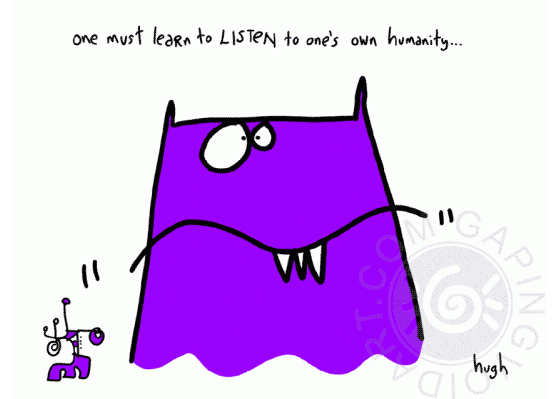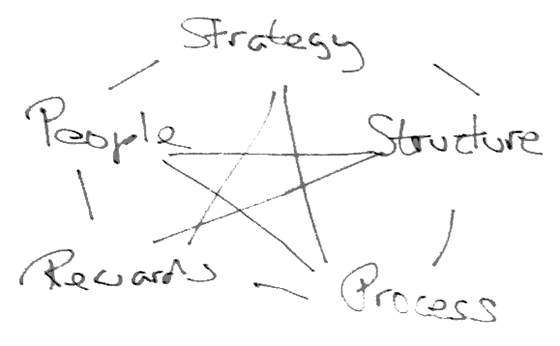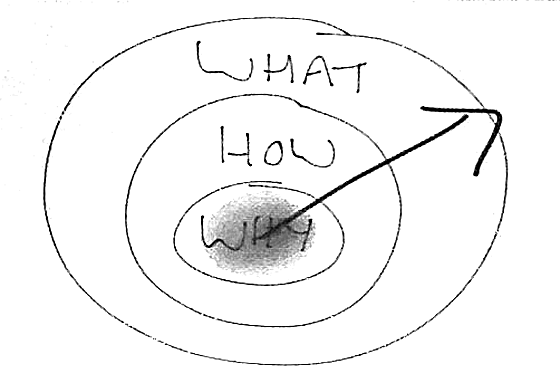Surfing a couple of Tumblrs, I am an expert on the topic of “the deeply absurd”. Knowledge, meet practice: I recently went to a “Lean Kanban” (it’s a project management thing) conference here in London, which turned out to be a portentous source of fantastic absurdities which I thought to share.
While the first speaker was parsimonious as to dispensing absurdities, the second one, a druid-looking guy dressed like a biker, more than made up for the first one. He touched on the following topics: accidental discovery, sinking submarines (?), tables with magnets and ball bearings (“infinite resistance table”, he precises), complexity theory, coevolution, Mark Twain quotes, counterterrorism, Chomsky theory of language (“debunked 30 years ago”, we had to finally clear the air there), the wisdom of crowds. The order is not the original, not that it matters one bit.
Worth quoting a couple of passages: “scanning range and consequence resilience linked to subconscious” and “shallow dive into chaos”. The first one will be a googlewhack as soon as a google spider finds it here, the second one will lead you to either some deranged speed metal forum or to this diagram (shown in the talk):

This is called something like the “Cynefin model” (no it’s not pronounced like that) but let’s call it “hemorrhoids” here, because no one knows what Cynefin is but hemorrhoids are indeed well known and at least they carry some information, if anything in relation to the looks of the quadrants.
It’s a typical 2×2 diagram, right? Yeah kind of, but you see the part in the middle obviously represents disorder, no?, it’s the dark brown smelly thing that comes out of the hole and sticks all over the slide, and also that weird dark little “pedestal” thingy at the bottom of the “cross” obviously represents something else but in fact I can’t tell, so wait maybe it’s not that obvious. Can you use this as a map? Sure:

So you see that for example going from “chaotic” to “complicated” requires you to pass through “complex” via a wobbly path, and turn on your head three times. Can you go from “simple” to “chaotic”? Nah, impossible.
Also a selected passage about this map from the author’s blog (so, this is in writing):
“I think there is more work to do here on the nature of observation and orientation, in particular looking at what filters are permitted or used and the degree to which information is sought, stumbled upon or ignored. Boyds various forms of orientation also merit further treatment but for the moment this is it! I’ve been playing with it for the best part of a year time to put it in the public domain.”
I can’t wait to read what’s going to be shared in the public domain next year, possibly more “boyds various forms of orientation”.
He closed with the following drawing:

I never understood the fascination of the internets with Gaping Void, but at any rate this particular choice reminds us that one must learn to listen to chinese fortune cookies, and maybe who knows, the cipher on the bottom left will reveal its meaning to us through the medium of another druid dressed like a motor-biker, and so on and so forth in a recursive chain of druids dressed like motor-bikers.
The only other quote I wish he said is: “it is not the spoon that bends, it is only yourself”. Also some fibonacci mysticism was in order, but maybe he just didn’t have enough time. In fact he didn’t have time to stay after the talk because he had a train to catch, fact which he announced to the audience with importance, mind you, rather than with apology. So.
The next talk was from a guy who was dressed like a mime and shows us a picture of him in mime make-up. I wished he proceeded to mime us more about his mime stuff, but instead he told us about “low friction” something (“low-friction” meant “easy peasy” in this particular context) and the climax of the presentation is a reinvention of the Gantt chart, but without any mention of “Gantt chart”. Mentioning Gantt charts in the modern PM world invites for mockery, but one can just reinvent them by using a slightly different formatting and by calling them something else, without references to the original concept, that seems to go down just fine.
The next talk is by a guy with a vastly oversized purple quidditch t-shirt, with “Gryffindor” and a giant “07” on the front and “Potter” (as in Harry Potter) on the back. The “07” is written with sticky tape that is coming off a bit. The title of the talk is “How to know what you do know”. The first way to know what you know is to take any five buzzwords and connect them all to each other, and then perhaps step inside and carry out a satanic ritual.

The second way to know what you know is to do this:

The third way to know what you know is to Create Opportnity (with the spelling mistake) Remedial External.

One could wonder whether those are the only four concepts that deserve to be in the list, if their order is correct, and whether those exact words are the best expressions of their respective concepts. The answer is yes, yes, yes, because the acronym says “CORE”, so either that’s a coincidence (silly you) or that’s a sign from the universe that we are tapping into some very serious stuff here (more likely).
The next talk is titled “reach for the stars”. The guy wears a stained NASA T-shirt and he confesses that he wishes he worked at NASA. After a couple of slides on queue theory he takes us on a field trip around galaxies and random engineering details of ISS, Hubble and Apollo missions. The gist of the talk is that everything should be done with supreme excellence. [Cut] Stained NASA T-shirt. [Cut] Supreme excellence. [Cut] Stained NASA T-shirt. [Cut] Supreme excellence. [Fade].
Next talk is titled “TBC” and the speaker highlights what’s confusing and contradictory in the other talks. This guy obviously had the easiest job ever, and frankly I thought I could use his collection to write my disparaging blog entry. But no, I had to do all the work myself, because he starts by arguing with some other chap in the audience that one should always be transparent about his/her opinions. That said, he builds up the next dozen slides on how to be diplomatic, and the conclusion is that one should apply common sense and one can’t always be transparent about his/her opinions. He uses a drawing of a ladder to explain that (the first two steps strangely have a different color than the others), and one of the punch lines is “Does my arse look big in these”.
The next talk is about the structural organisation of a famous company in the music industry. Opening slide is that their aim is to “Change The World” with their product – this is so important that it’s repeated several times in all-important tone, the guy is very serious and he is not here to mess around. So for the rest of the slides I had this little “spot the odd one out” game going in my head: a) fire b) wheel c) writing d) the number zero e) the steam engine f) electricity g) computers h) another music player app. Now think for a second of a company were people would have trouble picking option “h” over the others, and one gets an idea of where on the map “pinnacle of self-absorption” is.
Finally over, coming out of the room I spot a man-tall promotional banner of a company supporting the conference, which sells a software to attach digital stickies around the screen.

I had a hot teacup burning my hand but it didn’t matter, nothing mattered, I just stared at this for a couple of minutes, glazed gaze, teleported in an intellectual Las Vegas of leather-jacketed druids and hermetic slides. Then looked around to check whether there were candid cameras. No, none.
Everyone looks and acts natural.